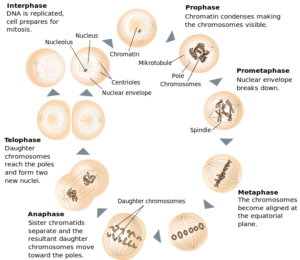Table of Contents
INTRODUCTION
Mitosis is the process of cell division. It is the phase of the cell cycle in which the newly formed DNA is separated and two new cells with the same number and type of chromosomes as the parent nucleus are formed. With the exception of viral cells, most eukaryotic cells divide in such a way that the ploidy or chromosome number remains unchanged.
During growth and development, the body of living organisms reprograms cells through the process of mitosis. Throughout its life, mitosis replaces old cells with new ones. The mitotic division is a type of production that adds young people to the number of single-celled eukaryotes. The ultimate goal of Mitosis is to ensure that each daughter-made cell has a complete and complete set of chromosomes. This may not work well if the cells are overgrown or without chromosomes.
Features of Mitosis

- In each mitotic cell division of mitosis, two female cells are formed in the mother cell.
- This means that each nucleus separates once in the cycle of each cell.
- In size, shape, and chromosome, the daughter cells resemble the mother cells.
- The chromosome number in the daughter and mother cells is the same, known as the equational or homotypic division.
- Mitosis also occurs in the organs of the somatic plant. This can be found in the stem tip, root tip, and leaf base. Mitosis is a process in which plants grow their vegetable components.
- The whole mitosis process is made up of only one parallel or homotypic component.
- There is no recurrence or separation during the mitosis phase.
Stages of Mitosis
The cell cycle is the time when one cell division cycle is completed. The cell cycle is divided into two phases, the Interphase, and the Mitotic phase
Interphase is where DNA is synthesized, and the mitotic phase is when nuclear dissociation occurs. The time required to complete the cell cycle varies from species to species.
Interphase
The cell spends most of its time growing in the interphase before entering mitosis. Once in the interphase, it goes through the following stages:
Phase G1: This is the pre-DNA sequence.
Stage S: This is the stage at which DNA formation occurs.
Phase G2: The time between the end of DNA synthesis and the beginning of prophase.
Mitosis phase
During the mitotic phase, repeated DNA is divided into two female nuclei. Occurs in the absence of reunification. This means that the daughter’s nuclei will have the same chromosome combination as the parent nucleus.
In addition, there are four categories under the mitotic category and these are-
Prophase
Propose begins after the G2 phase of the interphase. The chromosome appears to be a small, uncovered series in the first phase of prophase. The chromosome is attractive and short, and very different, between mid-prophases. The chromosome will appear thicker, shorter, and more prominent in prophase late, as well as twice as long.
Metaphase
The next phase of prophase is known as metaphase. Twisting tubes are formed during this phase, and the chromosome is directed toward the centre of the equatorial plate. There is a spinning tube that connects the chromosome to the centre. Chromosomes are clearly visible during metaphase. The chromatids that are the sisters of each chromosome are centred on the centre, but their arms remain free.
Anaphase
Anaphase begins with the division of chromatids into sisters. These sister chromatids are the chromosomes of the daughter nuclei. Fibres are connected to the kinetochores of each chromosome and then pull the chromosomes toward the pole.
Each chromosome leads the centromere to the edge, the arms following behind it.
Telophase
During the telophase, the chromosomes converge into two poles that begin to assemble into a separate mass as the nuclear envelope surrounds them. The nucleolus, the Golgi bodies, and the ER complex, which had disappeared during prophase, begin to reappear.
Also read: Mitochondria
Activities of Mitosis
- Mitosis, or cell division, helps a living thing to grow from baby to adult.
- Mitosis also performs growth and repair functions.
The Importance of Mitosis
- It is responsible for the growth and development of the body.
- It keeps the number of chromosomes fixed in all the body cells of an organism.
- Mitosis is required for asexual reproduction, plant proliferation in plants, and is responsible for tissue repair and regeneration.
- Mitosis contributes to the cleanliness of the genome by preventing reunion and crossing.
- It is responsible for repairing and regenerating old and damaged cells in animals, such as gut epithelium and blood cells.
- Mitosis is a major physical re-organisation of cellular content to form two new cells that are reliable images of their mother.
- It involves the construction of specific motility structures to separate chromosomes and to separate the cytoplasm.
- Mitosis control is driven by protein modification and controlled proteolysis, which is linked to performing key mitotic events through a system of test sites that ensure quality control.
Methods linking biochemistry and genetics with cell biology have produced an unprecedented view of mitosis complications that will concern researchers for some time. Uncovering these complexities should provide new insights into mitosis, especially in the context of structurally differentiated tissues, and produce new therapeutic interventions for increasing diseases.





